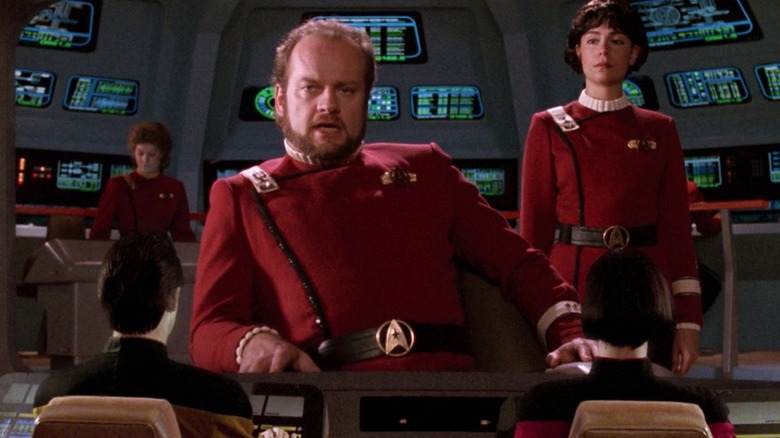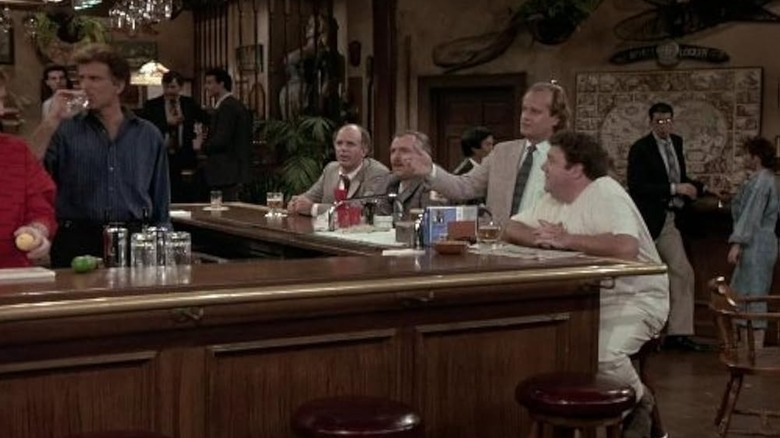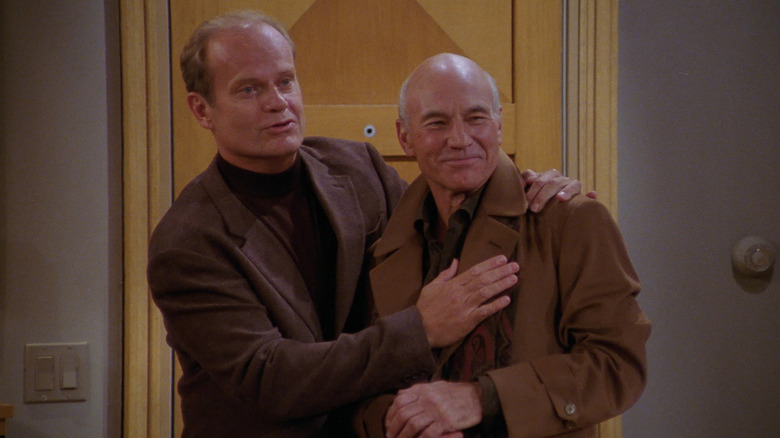This Star Trek Theory Will Have You Looking Twice At Cheers & Frasier
In the "Star Trek: The Next Generation" episode "Cause and Effect" (March 23, 1992), the U.S.S. Enterprise-D enters a recurring time loop, forcing the people on board to relive the same day over and over again. At the start of the day, several members of the senior staff gather for a game of poker. At the end of the day, the Enterprise collides with a mysterious other ship and explodes, killing everyone on board. When time resets, the Enterprise crew has no memory of what happened.
Of course, thanks to some elaborate clues, the crew does eventually find out what's happening, and even develop a means to sent additional clues backward into the next time loop. In the next repetition, the crew finally deciphers their own hints and escapes the loop by dodging the mysterious ship. Once freed, the Enterprise-D contacts that ship, and finds it is the U.S.S. Bozeman. The captain of the Bozeman is one Morgan Bateson, played by celebrity guest Kelsey Grammer. "Cause and Effect" aired during the final season of "Cheers" and just before the premiere of "Frasier," two shows that starred Grammer, so the episode was a fun sci-fi stop-gap for "Cheers" fans.
Seeing Grammer in "Cause and Effect," however, has caused some Trekkies to begin pondering. Grammer, it seems, isn't the only "Cheers" cast member to appear on "Star Trek." Indeed, before she was on "Cheers," Kirstie Alley played the Vulcan Saavik in "Star Trek II: The Wrath of Khan." Bebe Neuwirth, who played Frasier's wife Lilith on 80 episodes of "Cheers," also played an alien in the "Next Generation" episode "First Contact." And Kate Mulgrew, who played Captain Janeway on "Star Trek: Voyager," appeared on three episodes of "Cheers" as a character named Janet Eldridge.
And they are hardly the only ones. Which begs the question: what if the world of "Cheers" is actually just a holodeck simulation regularly visited by "Star Trek" characters?
A fan theory states that Cheers is just a holodeck program inside of Star Trek
This has been theorized by fans of both "Cheers" and "Star Trek" for many years, and it is, of course, idle speculation. But then, idle speculation is a full-contact sport for Trekkies, so let's dive in.
Holodecks are, for those unfamiliar, the high-tech environmental simulation chambers used for recreation on the U.S.S. Enterprise. They are essentially fully-immersive, wholly realistic video games wherein the players interact with holographically created NPCs and complete artificial environments. They were first introduced in the "Star Trek: The Animated Series" episode "The Practical Joker" (September 21, 1974), but became common on "Star Trek: The Next Generation" 13 years later. Often, the Enterprise's crew would enact semi-scripted stories — murder mysteries were of particular appeal — but sometimes they would create beaches or glades just to hang out.
On "Star Trek: Voyager," the entire crew became very fond of a recreation of Chez Sandríne, a centuries-old bar in Marseille. On their off hours, the crew would drift in and out of Chez Sandríne, as they always wanted to go where everybody knew their names.
In the light of Chez Sandríne, it doesn't take much cognitive stretching to picture Cheers, the lovely little watering hole on Beacon Street in Boston, as a hologram where Starfleet officers visit as an escape from the stresses of their high-pressure space jobs. Frasier Crane is, in fact, a role that Captain Morgan Bateson is playing on the holodeck of the U.S.S. Boseman. He would romance the "Diane" character (Shelley Long), but would have had to program Diane to leave him at the altar to bring his little game to a close.
Why did Captain Bateson want to end his holographic game with Diane? Because his next wife, "Lilith," was a real person from the "Star Trek" universe.
Many Star Trek characters visit the holographic world of Cheers
In the "Star Trek: The Next Generation" episode "First Contact," Bebe Neuwirth played an alien named Lanel who belonged to a society on the cusp of inventing faster-than-light travel. By the rules of "Star Trek," that meant the Federation could officially make contact; Starfleet doesn't mess with pre-warp societies. Lanel discovered that Commander Riker (Jonathan Frakes) was living among them and — in a randy twist — offered to help him escape if he went to bed with her. "I've always wanted to make love to an alien."
Lanel must have escaped her planet at some point later, made her way to a holodeck, and begun interacting with "Cheers," playing the part of "Lilith." While on a holodeck, Captain Bateson must have met her, and the pair play-acted a married couple, Lilith and Frasier Crane.
The bartender "Rebecca" was, of course, the Vulcan officer Saavik (Kirstie Alley), long-lived and visiting a holodeck and play-acting as a human. Saavik might have been interested in the human notion of "marrying for money," and studied the idea through the imaginary Rebecca character.
As established in "Voyager," Captain Janeway (Mulgrew) can indeed fall in love with holographic characters, as she once had a thing for the imaginary 19th century Irish bartender Michael Sullivan (Fintan McKeown). It seems that Michael Sullivan wasn't the first holographic bartender she had an affair with, as she once posed as a character named Janet Eldridge and romanced the "Cheers" bartender Sam (Ted Danson). That would mean, of course that Sam is a hologram.
While Norm (George Wendt) looks like a human, there's every reason to believe that he is, in fact, the laconic Lurian Morn (Mark Allen Shepherd) frequently seen on Deep Space Nine. In an uncreative twist, Morn — a barfly in real life — plays a barfly on the holodeck as well.
(Fun trivia: Morn was named after Norm by the "Deep Space Nine" writers)
Captain Picard and Data even joined in on the action
Data (Brent Spiner) often visited to holodeck to play Sherlock Holmes, rehearse stand-up comedy, or to explore other facets of humanity through simulated social interactions. Data could even pretend to be human, taking on accents and personality quirks. One of his social experiments, it seems, was visiting the holographic Cheers to go on a date. Spiner appeared in the "Cheers" episode "Never Love a Goalie, Part 2" (February 5, 1987). This would have been, however, right when Data met his fellow Enterprise-D officers, so the creation of the simulated Cheers predates the arrival of Captain Bateson.
If "Cheers" is a simulation, then "Frasier" is also a simulation wherein Captain Bateson is living a full, second life. It's possible that Captain Bateson, because he was displaced in time, used a holodeck fantasy to cope with a decades-long gap in his life. Very occasionally, Bateson's Starfleet companions would check in on him, including Captain Picard (Patrick Stewart). In the "Frasier" episode "The Doctor is Out," (September 30, 2003) Picard entered the holodeck to play a character named Alistair Burke to enact a warm friendship curious homoerotic drama with his fellow Captain. Playacting in farces, it can be posited, is good therapy.
It does make some "Star Trek" sense that Picard and Bateson would pretend to be parts of a farce, as Starfleet captains have to be serious and staid most of the time. Having a bit of a laugh together would be necessary.
Many minor Star Trek aliens also visited the Cheers'/'Frasier holodeck program
Other "Star Trek" characters would also dip into the (hypothetical) "Cheers"/"Frasier" simulation from time to time as well, although some of them require a great deal of brain-strain to make them fit into "Star Trek" canon. Actor Saul Rubinek, for instance, played the evil collector Kivas Fajo on "Star Trek," and that character was arrested and taken to prison. How, then, would he be free to play-act Daphne's fiancé in 15 episodes of "Frasier"?
Or how did the Traveler (Eric Menyuk), a strange cosmic being who can travel through space on his own consciousness, enter the holodeck to play a friend and co-worker of Cliff (John Ratzenberger)? Particularly baffling is the case of Vaughn Armstrong, who currently holds the record for most live-action characters played in the "Star Trek" franchise. Armstrong played 12 characters throughout "Star Trek," and then multiple others in the "Cheers"/"Frasier"-verse. Which "Star Trek" Armstrong was playing which "Cheers" Armstrong? I shan't theorize here.
And how in the galaxy did Captain Kruge (Christopher Lloyd), the villain of "Star Trek III: The Search for Spock," make his way to a holodeck to play Phillip Semenko in a miniature "Cheers" story arc (specifically, the episode "I'll Be Seeing You")? That would have been especially hard, since Kruge died in "Search for Spock." Maybe the Genesis wave resurrected Kruge in a new body, and the Klingon survived into the 24th century to explore art and humanity with a newer, gentler heart.
And why would Worf's mother Helena Rozhenko (Georgia Brown) go to the "Cheers" holodeck to play a fortune-teller named Madame Lazora? Maybe she was visiting Worf (Michael Dorn) on the Enterprise, and heard that her son's friends like to visit this holographic bar? And decided to try it herself? Incidentally, Georgia Brown received an Emmy nomination for playing Madame Lazora.
Of course, all of this is just fun speculation and not canonical ... unless it is.




